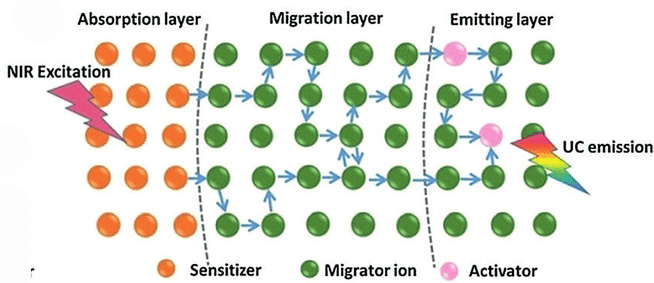Photon Upconversion Nanoparticles: Revolutionizing Light Conversion
Definition: Photon upconversion nanoparticles (UCNPs) are a class of nanomaterials that can convert low-energy photons into higher-energy photons. This unique capability enables applications in bioimaging, photodynamic therapy, and solar energy conversion, distinguishing them as a pivotal advancement in nanotechnology and materials science.

Understanding Photon Upconversion
Photon upconversion involves a series of non-linear optical processes where the sequential absorption of two or more photons leads to the emission of a single photon with energy greater than the sum of the absorbed photons. UCNPs are engineered to optimize this process, utilizing rare earth ions to facilitate efficient energy transfer and emission at desired wavelengths.
Mechanism and Composition
The core mechanism of upconversion in UCNPs involves energy transfer processes among doped rare earth ions, such as erbium (Er3+) and ytterbium (Yb3+). The choice of host material, typically a crystalline lattice like sodium yttrium fluoride (NaYF4), provides a conducive environment for maximizing photon upconversion efficiency.
Advantages and Applications
UCNPs offer several advantages over traditional fluorophores, including higher photostability, less photobleaching, and deeper tissue penetration due to their ability to convert near-infrared light to visible or ultraviolet light. These properties make UCNPs ideal for:
- Bioimaging: UCNPs are used in high-resolution imaging techniques, offering clearer images of deep tissues with minimal background noise.
- Photodynamic Therapy: By converting near-infrared light to the wavelengths required to activate photosensitizers, UCNPs enhance the effectiveness of treatments targeting cancer and other diseases.
- Solar Energy Conversion: UCNPs can harness the broader spectrum of solar radiation, converting low-energy infrared light into high-energy photons that can be utilized by solar cells, thereby increasing their efficiency.
Challenges and Research Directions
Despite their promising applications, the practical use of UCNPs faces challenges such as the need for high-power light sources for excitation and the optimization of their optical properties for specific applications. Ongoing research is focused on improving the efficiency of UCNPs, developing new materials for upconversion, and exploring innovative applications in security, sensing, and environmental monitoring.
Recent Advances and Future Outlook
Recent advancements in nanoparticle synthesis and functionalization have led to more efficient and tunable UCNPs, broadening their applicability in various fields. As the understanding of their fundamental properties grows, future research aims to unlock the full potential of UCNPs, promising new technologies for medical diagnostics, environmental science, and renewable energy.
Further Reading
Nature Communications, Advances in highly doped upconversion nanoparticles
